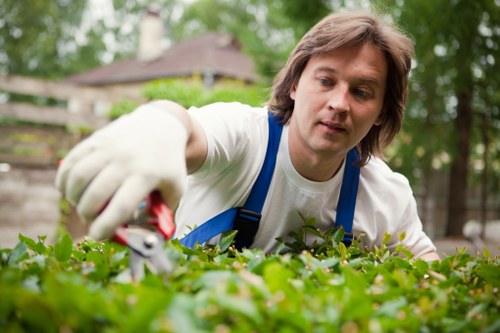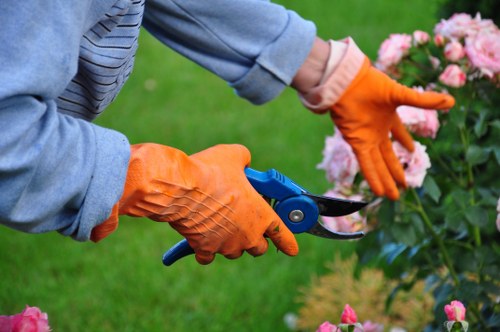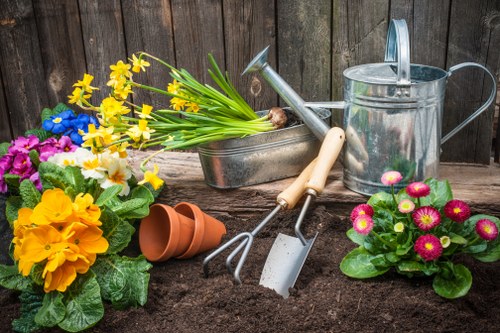Comprehensive Guide to Hedge Trimming in Tooting
Introduction to Hedge Trimming

Hedge trimming is an essential aspect of maintaining the beauty and health of your garden. In Tooting, where gardens are a cherished part of residential life, keeping hedges well-trimmed not only enhances curb appeal but also promotes healthy plant growth.
Regular hedge maintenance can prevent overgrowth, reduce the risk of pests, and ensure that your hedges complement the overall landscaping of your property.
Whether you have a small garden or a large estate, understanding the basics of hedge trimming can make a significant difference in the appearance and longevity of your greenery.
Why Hedge Trimming is Important

Trimming your hedges offers numerous benefits. Firstly, it encourages dense and bushy growth, which is not only aesthetically pleasing but also acts as a natural barrier against noise and pests.
Moreover, regular trimming helps maintain the shape and size of your hedges, making garden maintenance more manageable and preventing them from becoming unruly.
Additionally, well-maintained hedges can increase your property's value, making it more attractive to potential buyers if you ever decide to sell.
Best Times for Hedge Trimming

Timing is crucial when it comes to hedge trimming. In Tooting, the best seasons for trimming hedges are late winter or early spring, just before new growth begins. This timing allows the plants to recover quickly and promotes vigorous growth during the growing season.
Another suitable time is late summer after the main growth period has slowed down. Avoid trimming during the peak growing season or approaching winter, as this can stress the plants and make them more susceptible to disease.
Understanding the growth cycle of your specific hedge species is essential to determine the optimal trimming schedule.
Techniques for Effective Hedge Trimming

Tools You’ll Need
Having the right tools is essential for efficient hedge trimming. Common tools include:
- Hedge shears: Ideal for smaller hedges and precise trimming.
- Electric or gas-powered hedge trimmers: Suitable for larger hedges, providing quicker and more uniform cuts.
- Pruning saw: Useful for cutting thicker branches that regular trimmers can't handle.
- Protective gear: Gloves, safety glasses, and appropriate footwear to ensure safety while trimming.
Step-by-Step Trimming Guide
Follow these steps for effective hedge trimming:
- Assess the Hedge: Determine the desired shape and size of your hedge.
- Clean Tools: Ensure all trimming tools are clean and sharp to make precise cuts.
- Start Trimming: Begin at the top, working your way down to maintain a uniform shape.
- Even Out the Sides: Trim the sides gradually, stepping back frequently to check for symmetry.
- Finishing Touches: Remove any stray branches and ensure the base of the hedge is neat.
Types of Hedges Popular in Tooting

Boxwood Hedges
Boxwood hedges are favored for their dense foliage and ability to be shaped into various forms. They are evergreen, providing year-round greenery.
Privet Hedges
Privet is another popular choice due to its fast growth and adaptability. It can be easily trimmed to maintain a formal appearance.
Laurel Hedges
Laurel hedges are known for their thick, glossy leaves and rapid growth. They are excellent for creating privacy screens.
Pyracantha Hedges
Pyracantha offers not only dense foliage but also vibrant berries, adding color and interest to your garden.
Choosing a Professional Hedge Trimming Service in Tooting
While DIY trimming is possible, hiring a professional ensures precision and saves time. Professional services in Tooting offer expertise in various trimming techniques, ensuring your hedges remain healthy and well-shaped.
When selecting a service, consider factors such as experience, customer reviews, and the range of services offered. A reputable company will provide a comprehensive assessment and tailor their approach to your specific needs.
Investing in professional hedge trimming not only enhances your garden's appearance but also adds to the overall health and longevity of your plants.
DIY Hedge Trimming Tips
If you prefer to trim your hedges yourself, here are some tips to ensure success:
- Plan Ahead: Decide on the shape and height before you start trimming.
- Use the Right Tools: Ensure your tools are suitable for the type and size of your hedge.
- Work in Sections: Divide your hedge into manageable sections to maintain consistency.
- Maintain Safety: Wear appropriate gear and be cautious of overreaching.
- Regular Maintenance: Trim your hedges regularly to prevent overgrowth and reduce the effort required each time.
By following these tips, you can achieve a well-maintained hedge that enhances your garden's beauty.
Remember, patience and attention to detail are key to successful DIY hedge trimming.
Consistent maintenance will keep your hedges looking their best throughout the year.
Common Mistakes to Avoid
Trimming hedges might seem straightforward, but several common mistakes can compromise the health and appearance of your plants:
- Over-Trimming: Cutting too much at once can stress the plant and reduce its ability to recover.
- Ignoring Plant Health: Neglecting signs of disease or pest infestation can lead to serious problems.
- Improper Tool Maintenance: Dull or dirty tools can cause uneven cuts and spread diseases.
- Wrong Timing: Trimming at unsuitable times of the year can hinder growth and repair.
- Neglecting Safety: Failing to use protective gear can result in injuries.
Avoiding these mistakes ensures that your hedges remain healthy, attractive, and a valuable part of your garden.
Regularly inspecting your hedges for any issues can help you address problems before they escalate.
Proper technique and care are essential for maintaining the integrity of your hedges.
Environmental Benefits of Hedge Trimming
Maintaining well-trimmed hedges offers several environmental advantages:
- Promotes Biodiversity: Healthy hedges provide habitats for various species, enhancing local biodiversity.
- Improves Air Quality: Dense foliage helps filter pollutants and produce oxygen.
- Reduces Carbon Footprint: Well-maintained hedges can act as carbon sinks, absorbing CO2 from the atmosphere.
- Controls Soil Erosion: The roots of hedges help stabilize the soil, preventing erosion.
- Enhances Microclimates: Hedges can moderate temperatures and provide windbreaks, creating a more comfortable outdoor environment.
By investing time and effort into hedge trimming, you're contributing positively to the environment while beautifying your space.
Choose eco-friendly trimming practices to maximize these benefits.
Consider using sustainable tools and materials to further enhance the environmental impact.
Choosing the Right Hedge Trimmer
Selecting the appropriate hedge trimmer is crucial for efficient and effective trimming. Consider the following factors:
- Type of Hedge: The species and density of your hedge will determine the type of trimmer needed.
- Size of the Hedge: Larger hedges may require electric or gas-powered trimmers, while smaller ones can be managed with manual shears.
- Ease of Use: Look for trimmers that are comfortable to handle and easy to maneuver.
- Safety Features: Features like safety switches and ergonomic designs can prevent accidents.
- Maintenance: Choose trimmers that are easy to maintain and have readily available replacement parts.
Investing in a high-quality hedge trimmer can make your trimming tasks easier and more efficient.
Regular maintenance of your tools ensures their longevity and performance.
Consider reading reviews and seeking recommendations to find the best trimmer for your needs.
Seasonal Hedge Trimming Tips
Spring Trimming
Spring is an ideal time to give your hedges a fresh start. Remove any winter damage, trim the sides to encourage new growth, and shape your hedges for the upcoming season.
Summer Maintenance
During summer, focus on maintaining the shape and size of your hedges. Regular light trimming can prevent overgrowth and keep your hedges looking neat.
Autumn Trimming
In autumn, prepare your hedges for winter by trimming back any excessive growth. This helps reduce the risk of damage from heavy snow or frost.
Winter Care
While heavy trimming should be avoided in winter, inspect your hedges for any damage and make minor adjustments if necessary.
Aftercare for Trimmed Hedges
Proper aftercare ensures that your hedges recover well from trimming:
- Watering: Provide adequate water, especially during dry periods, to help your hedges recover.
- Fertilizing: Apply a balanced fertilizer to promote healthy growth.
- Pruning Debris: Remove any fallen leaves and branches to prevent disease and pests.
- Monitoring Health: Keep an eye on your hedges for any signs of stress or disease.
- Mulching: Apply mulch around the base to retain moisture and regulate soil temperature.
Consistent aftercare practices can significantly enhance the health and appearance of your hedges.
Addressing any issues promptly ensures long-term benefits and reduces maintenance efforts.
Stay committed to regular care routines for the best results.
Cost of Professional Hedge Trimming in Tooting
The cost of professional hedge trimming in Tooting varies based on factors such as the size of the hedge, the complexity of the trimming required, and the service provider's rates.
On average, homeowners can expect to pay between £50 to £150 for a standard hedge trimming service. Larger or more intricate jobs may cost more.
It's advisable to obtain quotes from multiple providers and compare services to ensure you receive the best value for your investment.
Benefits of Regular Hedge Maintenance
Regular hedge maintenance offers sustained benefits:
- Enhanced Aesthetics: Consistently trimmed hedges contribute to a well-kept and attractive garden.
- Improved Plant Health: Regular trimming promotes healthy growth and reduces disease risk.
- Increased Property Value: Well-maintained gardens are a significant asset to any property.
- Environmental Impact: Healthy hedges support local ecosystems and contribute to better air quality.
- Personal Satisfaction: A beautiful garden provides a sense of pride and relaxation.
Investing time or resources into regular hedge maintenance pays off in multiple ways, ensuring your garden remains a source of beauty and enjoyment.
Consider setting up a maintenance schedule to keep your hedges in optimal condition.
Consistency is key to reaping the long-term benefits of hedge trimming.
DIY vs. Professional Hedge Trimming
Deciding between DIY and professional hedge trimming depends on various factors:
- Skill Level: Professionals have the expertise to handle complex trimming, while DIY may be suitable for simpler tasks.
- Time: Hiring professionals saves time, allowing you to focus on other aspects of garden maintenance.
- Cost: While DIY may seem cost-effective, professional services provide quality results that can save money in the long run.
- Tools and Equipment: Professionals come equipped with the necessary tools, eliminating the need for you to invest in expensive equipment.
Evaluate your specific needs and resources to make an informed decision that best suits your situation.
Both approaches have their merits, and sometimes a combination of both can be the most effective strategy.
Consider starting with professional services and gradually taking on more tasks as you gain confidence and experience.
Conclusion
Hedge trimming is a vital part of garden maintenance in Tooting, offering numerous aesthetic, environmental, and economic benefits.
Whether you choose to undertake the task yourself or hire professionals, understanding the principles and best practices of hedge trimming ensures that your hedges remain healthy, attractive, and a valuable asset to your property.
Invest in regular maintenance, appropriate tools, and professional services when needed to achieve the best results.
Contact us today to schedule your hedge trimming service and enhance the beauty of your Tooting garden.